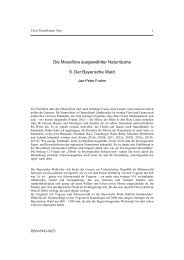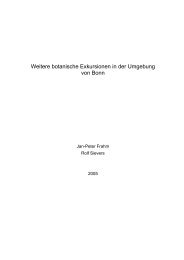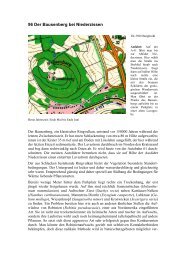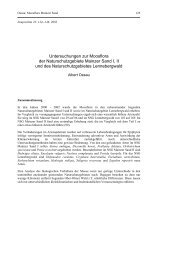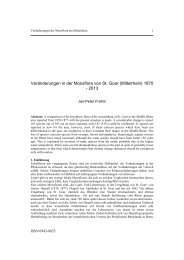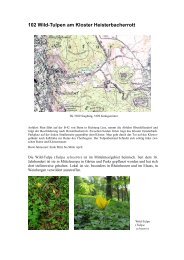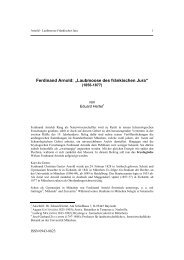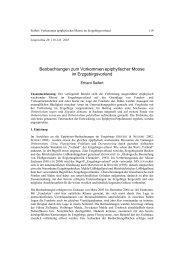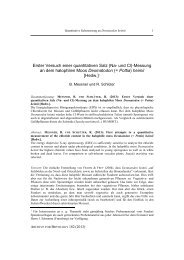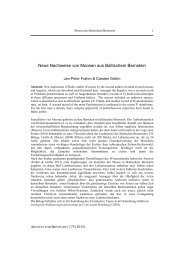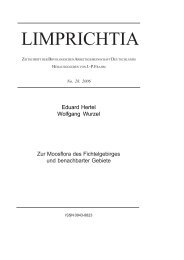Limprichtia xx: nn-nn, 2001 - Jan-Peter Frahm
Limprichtia xx: nn-nn, 2001 - Jan-Peter Frahm
Limprichtia xx: nn-nn, 2001 - Jan-Peter Frahm
You also want an ePaper? Increase the reach of your titles
YUMPU automatically turns print PDFs into web optimized ePapers that Google loves.
Mossflora Mascarenes 3<br />
Fifty three species reported from the Seychelles (almost half of its moss flora) are found only on<br />
this archipelago and no other islands of the Mascarenes. Mauritius has 82 species (33% of the<br />
species) which are exclusively found on this island, Réunion 206 species (56,2%).<br />
One hundred seven species are found on Mauritius as well as Réunion, which is almost half of the<br />
moss flora of Mauritius but a quarter of the moss flora of Réunion. Taking into account the higher<br />
elevation of Mauritius and therefore the species which have no adequate habitat on Mauritius, we<br />
have an accordance of about 50% of mosses on both islands. In contrast, the Seychelles share only<br />
42 species with Réunion and 49 species with Mauritius, which is a remarkably low number. The<br />
low percentage of accordance of Réunion might be due to the higher elevation since only part of<br />
the species from Réunion can exist on the Seychelles. The percentage of species from the<br />
Seychelles in common with Réunion or Mauritius is, however, around 40%.<br />
Tab. 2: Relationships between the moss floras of the Mascarenes<br />
see appendix Percentage of total<br />
Species only on the Seychelles 53 5 48,1<br />
Species only on Mauritius 82 7 33<br />
Species only on Réunion 206 6 39,7<br />
Species common on all islands 33 1 6,3<br />
Species on the Seychelles and 49 4 19,9 (Mauritius)<br />
Mauritius<br />
44,5 (Seychelles)<br />
Species on the Seychelles and 42 3 11,4 (Réunion)<br />
Réunion<br />
38,1 (Seychelles)<br />
Species on Réunion and Mauritius 145 2 58,9 (Mauritius)<br />
39,6 (Réunion)<br />
Species in total 519<br />
Species on Mauritius 246<br />
Species on Réunion 366<br />
Species on the Seychelles 110<br />
The poor moss flora of the Seychelles is striking: there is no one species of Leucobryum,<br />
Polytrichum is present with one species (but 4 in Réunion), Pogonatum is lacking (but 7 species in<br />
Réunion), Schlotheimia is lacking (but 11 in Réunion), Sphagnum is lacking (even in Mauritius<br />
are 5 species). The Seychelles are not more undercollected than the other islands, since species of<br />
Pogonatum or Polytrichum would have been collected. The lack of species on the Seychelles<br />
ca<strong>nn</strong>ot be explained by the geology (granite in contrast to volcanic soil on the other islands), nor<br />
the humidity (the highest parts are even more humid than the according regions on Mauritius) or<br />
the restriction of wet forests to small areas (similar to Mauritius). All islands are under the<br />
influence of the southeastern trade winds and have almost the same chances to be colonized by<br />
moss spores. It almost seems as if there has been an extinction event on the Seychelles. Or is this<br />
an effect of the small size?<br />
The high number (55) percentage of species on the Seychelles (appendix 5), which area confined<br />
to this archipelago, shows that it probably has conserved part of the Gondwanan flora. Its high age<br />
is reflected by a comparably “high” rate of endemism.<br />
ARCHIVE FOR BRYOLOGY 55 (2009)




